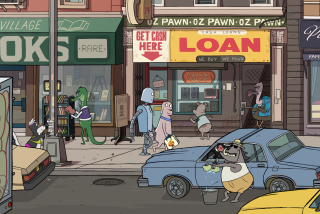Talking pancakes and foul-mouthed puppets: ‘Robot Chicken’ producer Stoopid Buddy Stoodios finds its niche

Stoopid Buddy Stoodios co-founders Eric Towner and Matt Senreich talk about their animation studio behind the stop-motion Adult Swim cartoon, Robot Chicken.
- Share via
In a nondescript Burbank business park, the creators of stop-motion animation house Stoopid Buddy Stoodios keep a 1970s Winnebago parked inside their offices. In keeping with the campground vibe, the company behind Adult Swim’s “Robot Chicken” gives employees merit badges and proudly displays its Buddy Code, modeled on a list of commandments found in the Winnebago. (“No. VI: Thou shalt respect the ’bago.”)
It’s a fitting setting for a company that follows its own rules when creating animated shows. In an animation industry dominated by slick computer-generated graphics, Stoopid Buddy, founded in 2012 by Seth Green, Matt Senreich, John “Harv” Harvatine IV and Eric Towner, has built a thriving business out of its aggressively analog and irreverent style of filmmaking.
In one room, rows of puppet makers with paint-stained aprons and blades are busy shaping 6-inch superheroes, decorating villains’ heads and assembling a wildly inappropriate Jewish robot. In another building, animators were slowly filming action scenes with miniature semi trucks and a 12-foot racetrack. There are rooms for voice-over recording, 3-D printing and even a puppet hospital.
“Doing animation’s a little like going to summer camp with your friends and making stuff,” Towner said in an interview at the company’s offices. “Any time you put 200 artists together, you get a lot of personality.”
Stoopid Buddy appears to have tapped into a powerful niche by applying a twisted sense of humor to an old-fashioned animation style with a handcrafted, do-it-yourself feel. Puppets are made out of plastic, fabric and old toys and appear in TV shows, commercials and movies.
There’s clearly a market for irreverent cartoons. Even major studio Sony Pictures scored a hit recently with the R-rated grocery store parable “Sausage Party,” which has grossed more than $100 million at the worldwide box office since it opened Aug. 12.
See the most-read stories in Entertainment this hour »
In the last 18 months, Stoopid Buddy has grown to 250 workers from 100 and has expanded to six buildings from just two. Annual sales have more than doubled in the last year, executives said, although they would not reveal financial figures for the privately held firm. While it has specialized in drawing young male viewers, Stoopid Buddy is trying to diversify by getting into 2-D animation, children’s shows and commercials.
“Even though we make stop-motion, we try to make every show we do look different from everything else,” Senreich said. “The one thing that stays consistent is the type of humor we’re doing.”
“Robot Chicken,” best known for using beloved action figures and nostalgic characters for diabolical ends, remains the company’s flagship product, with 1.5 million viewers an episode according to Nielsen. The latest season (its eighth) features a Mr. Monopoly in a “Fifty Shades of Grey” parody and a sketch in which science teacher Ms. Frizzle drives the Magic School Bus off a cliff.
“Robot Chicken” first aired on Adult Swim in 2005 and became one of the biggest late-night draws for the Cartoon Network offshoot. The series has won several Emmy Awards.
The sketches are manic, with some lasting just a few seconds. Beloved characters like Buzz Lightyear, Ewoks and the Muppets’ Swedish Chef meet brutal fates. While some of the throwback references can be obscure, the creators want to maintain an everyman feel for the show, creating the illusion that anyone with enough time could make “Robot Chicken” in their basement.
“They don’t mind if it strobes, they don’t mind if it’s crude,” USC animation Chair Tom Sito said. “That’s part of its charm. They like the kind of improv nature of it.”
Among its most popular creations are half-hour specials based on cultural touchstones such as “Star Wars” and the DC Comics superhero franchise. The team is planning a “Walking Dead” special for its upcoming ninth season, teaming with the zombie comic book franchise creator Robert Kirkman.
“It’s been exciting to see them build Stoopid Buddy Stoodios into a top-flight studio over the last few years,” said Keith Crofford, senior vice president of production for Adult Swim. “The ‘Robot Chicken’ series and themed specials are an important part of our original animation programming at the network.”
Stoopid Buddy’s origins stretch back to 2003, when Green and his partner Senreich first pitched “Robot Chicken” to Adult Swim at the suggestion of “Family Guy” creator Seth MacFarlane. Accomplished animators Towner and Harvatine joined the “Robot Chicken” team for the show’s second season, but later broke off to create their own company, Buddy Systems Studios.
In 2012, they merged with Green and Senreich’s production company Stoopid Monkey, mashed up the companies’ names and moved into their current Burbank offices, where they thought they could build a real business on the success of “Robot Chicken.”
They’re currently producing the second season of Crackle’s comic book spoof “SuperMansion,” which features the voice of Bryan Cranston as a geriatric superhero with a band of misfit crusaders. Animators are also plugging away on episodes of “Buddy Thunderstruck,” a kids show scheduled to hit Netflix in March. The company describes the show as a mix of “Fantastic Mr. Fox” and “Dukes of Hazzard,” set in a rural town called Greasepit.
Stoopid Buddy recently produced a more traditional-looking 2-D animation children’s pilot for Amazon called “Toasty Tales,” and another pilot for Adult Swim called “Hot Streets” about an FBI agent investigating the supernatural.
In addition, the crew is making a big push into advertising, creating spots for Ziploc and Goldfish crackers. Its Denny’s Web series, which features anthropomorphized talking pancakes, bacon and other breakfast items, has resulted in 20 episodes and counting.
The company has even started a division that makes life-size puppet costumes, which have been used in sketches for ABC’s “Jimmy Kimmel Live.”
Stoopid Buddy also has feature film ambitions. The team is writing a full-length animated movie with Sony Pictures called “Rabbids,” based on characters from a Ubisoft videogame franchise. It’s also working on a live-action, stop-motion hybrid titled “Superbago” with Sony, plus another picture for Fox Feature Animation. All those projects are in the development stages.
Stop-motion is a notoriously painstaking process, with animators moving their puppets millimeters at a time before each shot. It takes 12 to 13 months for Stoopid Buddy to create a season of a show like “Robot Chicken.” Because the style is expensive, and reshoots are cost-prohibitive, the studio meticulously plans every aspect before shooting begins. The filmmakers use a massive board of color-coded cards to schedule the workflow.
But despite the hardships, stop-motion has survived the digital revolution thanks a to a small, quirky group of artists and writers who have stuck with the old-school approach to making cartoons.
Recent films like “Shaun the Sheep Movie” by Aardman Animation and “Anomalisa” have kept the technique relevant, albeit for a different audience from the “Robot Chicken” crowd. Portland, Ore.-based studio Laika has produced a string of major stop-motion releases, including the Japan-set fantasy “Kubo and the Two Strings,” which was released last month to solid box-office numbers.
“It is a very small community,” Towner said. “You pretty quickly meet everyone who works in stop-motion animation once you get into it.”

Follow Ryan Faughnder on Twitter for more entertainment business coverage: @rfaughnder
ALSO
How Turner is changing the program to keep up with a new TV era
NBC News chief Andy Lack praises Matt Lauer’s presidential forum performance
Lydia Murphy-Stephans wants to lead Pac-12 Networks into the digital future
More to Read
From the Oscars to the Emmys.
Get the Envelope newsletter for exclusive awards season coverage, behind-the-scenes stories from the Envelope podcast and columnist Glenn Whipp’s must-read analysis.
You may occasionally receive promotional content from the Los Angeles Times.











